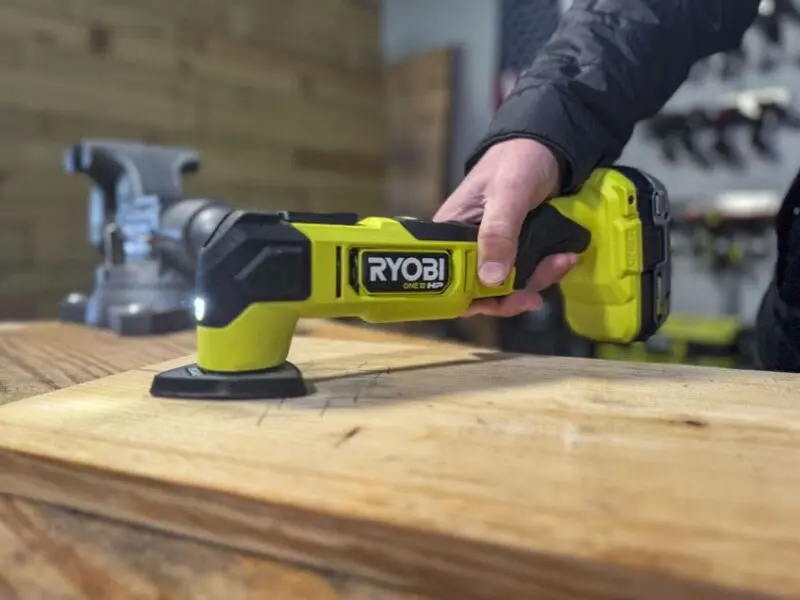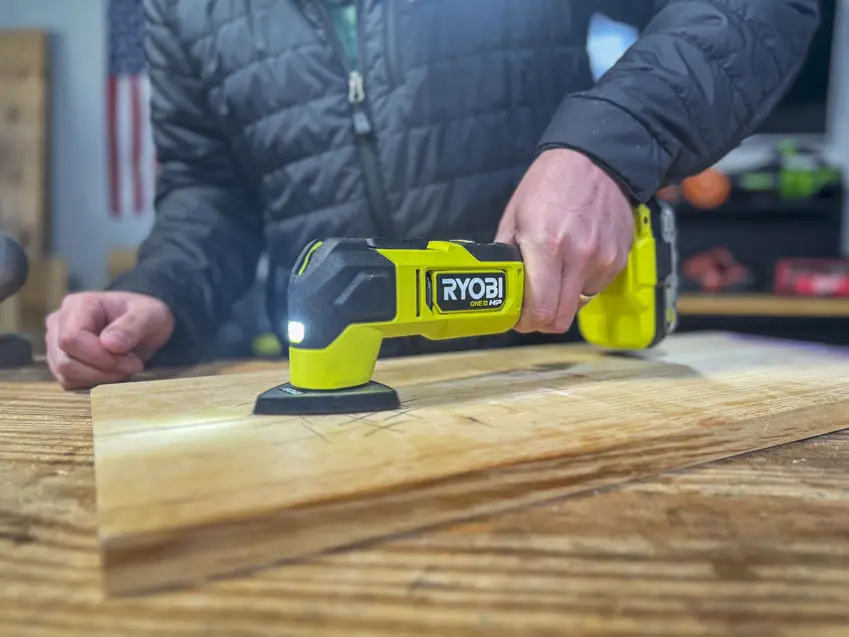Ryobi Ramps Up the Power on This Gen II Oscillating Multi-Tool
Ryobi’s High Performance, or HP Brushless, line of 18V tools has improved performance that rides the line of high-end DIY and entry-level Pro. With the Gen II Ryobi HP Brushless Oscillating Multi-Tool, they tells us to expect better performance than their previous 18V multi-tool along with a few other improvements.
Want to see more? Be sure to check out the Best Oscillating Multi-Tool Reviews of 2023!
Ryobi HP Brushless Oscillating Multi-Tool Performance

- Oscillations per Minute: 10,000 – 20,000 OPM
- Oscillation Arc Range: 3.8º
- Accessory Change System: Tool Free
- Variable Speed: Yes
The Ryobi HP Brushless Oscillating Multi-Tool features a brushless motor that the company says greatly improves the tool’s cutting speeds compared to their first 18V brushed model.
Considering both tools have a 10,000 – 20,000 OPM rate, you might expect them to have similar performance. It’s the oscillating angle that makes the difference. The first generation HP Brushless model had 3.6° of oscillating travel, but the Gen II model shifts to 3.8°. This allows for a faster and more aggressive cut.

Making a few test cuts, the difference was obvious. Digging a little deeper, we ran it through door jamb undercuts, drywall cutouts, popping nails holding trim in place, removing grout, and sanding.
Over the course of those applications, Ryobi proved that it has boosted its performance significantly. The best premium models still cut faster, but the cutting speeds we’re seeing put Ryobi on a much more relevant level than it has been.
The vibration control is about the same that we felt in the last model. It’s not as smooth as Milwaukee and Fein are, but it’s also not vibrating our fingernails off the way a few other models do.
Ryobi HP Brushless Oscillating Multi-Tool Design

- Model: Ryobi PBLMT51B
- Power Source: Ryobi 18V battery
- Weight: 1.9 lbs (bare), 2.9 lbs (with 2.0Ah High Performance battery)
- Length: 11.7 in.
Handle Design
Ryobi sticks with the up angled handle we saw on the previous model and it’s a double-edged sword. They improved the overall comfort and it fits nicely in your hand when you’re cutting with the tool in an upright position.
Variable Speed Dial
The Gen II Oscillating Multi-Tool, like the PBLMT50, also features a variable speed dial to set your speed. However, they switched back to a trigger with a lock button rather than an on/off switch. Personally, I tend to prefer a trigger because they offer a higher level of control, but there are good arguments for both styles.
Blade Changes

Like its predecessor, this model features a tool-free blade change system. Simply pull up on the release lever, slide the metal stop-bar out, and install your blade. It’s worth knowing that you can also position your blades and other implements at a variety of angles to suit your specific needs.
Ryobi Cordless Oscillating Multi-Tool Quick Comparison
| HP Brushless PBLMT50B | HP Brushless PLBMT51B | |
| Motor | 18V Brushless | 18V Brushless |
| OPM | 10,000 – 20,000 OPM | 10,000 – 20,000 OPM |
| Angle of Oscillation | 3.6º | 3.8° |
| Blade Change | Tool-free | Tool-free |
| Variable Speed Dial | Yes | Yes |
| Power Switch | Slide-on switch | Trigger with lock-on button |
| Length | 11.7 in | 11.7 in |
| Bare Weight | 1.9 lbs | 1.9 lbs |
Pricing and Availability
You can snag this model at your local Home Depot as a bare tool for $119. You’ll need to buy your battery and charger separately, but you do get a few accessories to get started. Ryobit backs this tool with a 3-year warranty.
The Bottom Line
The Gen II Ryobi HP Brushless Oscillating Multi-Tool took a good step forward in both performance and design. Its larger oscillation arc and redesigned nose make this a compelling option, plus, the price tag is hard to ignore. While there’s always room to grow, of course, we’re very pleased with Ryobi’s improvements.



